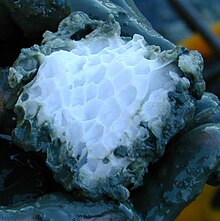Methane hydrate
Methane hydrate, also called methane clathrate or methane clathrate hydrate, is a clathrate hydrate type inclusion compound in which water molecules make up a crystalline structure through hydrogen bonding, giving rise to cavities inside which are methane molecules (or other light hydrocarbons such as ethane and propane in the case of natural gas hydrates) that stabilize the structure that, otherwise, it is thermodynamically unstable, but it does not establish chemical bonds with the water molecules of the structure.
Formation of methane hydrate
Methane hydrates are methane molecules in structures of water molecules, which under conditions of pressure and temperature that exist in the continental slope and in the polar regions (permafrost) become solid crystalline substances (methane ice). They are found mainly in the pores of sandy sediments cementing them.
In the marine environment its formation is explained in a somewhat complex way. The methane that results from the decomposition of living organisms in the water reacts with the water about to freeze, forming hydrates, which will later settle on the seabed. The reaction occurs under particular pressure and temperature conditions. Methane hydrate is particularly unstable.
Properties
One cubic meter of methane hydrate contains approximately 164 cubic meters of methane gas with only 0.84 cubic meters of water. This "ice" it is flammable: if a flame is brought near it, it releases methane gas which will burn.
Methane hydrates constitute an alternative energy source of great global projection, with estimated reserves that practically double the conventional reserves currently recognized for fossil energy resources. Thus, it is intended to use this compound as another fuel later, in a similar way to oil or natural gas.
During its extraction it is quite difficult not to release methane. This has limited its exploitation, since if methane is released into the atmosphere, we could increase the greenhouse effect considerably, with an effect 21 times greater than that of carbon dioxide.
History
In 1810 Humphrey Davy and Michael Faraday first described gas hydrates. In 1888 Villard experimentally found hydrates of CH4, C2H 6, C2H2 and N2O.
In 1930 Hammerschmidt determined that hydrates blocked gas pipelines and investigated inhibitor gases.
In 1960 the Soviets recognized methane hydrate as a possible energy source, and discovered and produced in small volumes the first hydrate deposit in the Siberian permafrost.
In 1990, the initial characterization and quantification of methane hydrates in deep-water deposits was carried out. In 2000, the efforts to quantify the characteristics and abundance of the hydrates begin, and the efforts to take advantage of the great potential of the hydrates as fuel begin.
Contenido relacionado
Soliton
Aquifex
Coding
